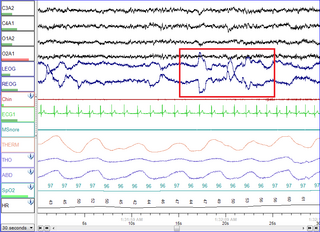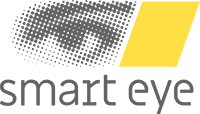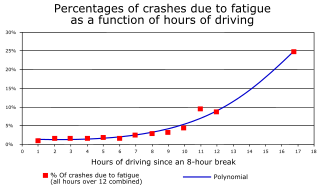Related Research Articles

An accelerometer is a device that measures the proper acceleration of an object. Proper acceleration is the acceleration of the object relative to an observer who is in free fall. Proper acceleration is different from coordinate acceleration, which is acceleration with respect to a given coordinate system, which may or may not be accelerating. For example, an accelerometer at rest on the surface of the Earth will measure an acceleration due to Earth's gravity straight upwards of about g ≈ 9.81 m/s2. By contrast, an accelerometer that is in free fall will measure zero acceleration.

Telematics is an interdisciplinary field encompassing telecommunications, vehicular technologies, electrical engineering, and computer science. Telematics can involve any of the following:
A microsleep is a sudden temporary episode of sleep or drowsiness which may last for a few seconds where an individual fails to respond to some arbitrary sensory input and becomes unconscious. Episodes of microsleep occur when an individual loses and regains awareness after a brief lapse in consciousness, often without warning, or when there are sudden shifts between states of wakefulness and sleep. In behavioural terms, MSs may manifest as droopy eyes, slow eyelid-closure, and head nodding. In electrical terms, microsleeps are often classified as a shift in electroencephalography (EEG) during which 4–7 Hz activity replaces the waking 8–13 Hz background rhythm.

An advanced driver-assistance system (ADAS) includes technologies that assist drivers with the safe operation of a vehicle. Through a human-machine interface, ADAS increases car and road safety. ADAS uses automated technology, such as sensors and cameras, to detect nearby obstacles or driver errors, and respond accordingly. ADAS can enable various levels of autonomous driving.

Driving simulators are used for entertainment as well as in training of driver's education courses taught in educational institutions and private businesses. They are also used for research purposes in the area of human factors and medical research, to monitor driver behavior, performance, and attention and in the car industry to design and evaluate new vehicles or new advanced driver assistance systems.

Polysomnography (PSG), a type of sleep study, is a multi-parameter study of sleep and a diagnostic tool in sleep medicine. The test result is called a polysomnogram, also abbreviated PSG. The name is derived from Greek and Latin roots: the Greek πολύς, the Latin somnus ("sleep"), and the Greek γράφειν.
Sleep-deprived driving is the operation of a motor vehicle while being cognitively impaired by a lack of sleep. Sleep deprivation is a major cause of motor vehicle accidents, and it can impair the human brain as much as inebriation can. According to a 1998 survey, 23% of adults have fallen asleep while driving. According to the United States Department of Transportation, twice as many male drivers than female drivers admit to have fallen asleep while driving twice.

Vehicle safety technology (VST) in the automotive industry refers to the special technology developed to ensure the safety and security of automobiles and their passengers. The term encompasses a broad umbrella of projects and devices within the automotive world. Notable examples of VST include geo-fencing capabilities, remote speed sensing, theft deterrence, damage mitigation, vehicle-to-vehicle communication, and car-to-computer communication devices which use GPS tracking.
The sopite syndrome is a neurological disorder that relates symptoms of fatigue, drowsiness, and mood changes to prolonged periods of motion. The sopite syndrome has been attributed to motion-induced drowsiness such as that experienced by a baby when rocked. Researchers Ashton Graybiel and James Knepton at the US Naval Aerospace Medical Research Laboratory first used the term "the sopite syndrome" in 1976, to refer to the sometimes sole manifestation of motion sickness, though other researchers have referred to it as "Sopite syndrome."

The driver monitoring system, also known as driver attention monitor, is a vehicle safety system to assess the driver's alertness and warn the driver if needed and eventually apply the brakes. It was first introduced by Toyota in 2006 for its and Lexus' latest models. It was first offered in Japan on the GS 450h. The system's functions co-operate with the pre-collision system (PCS). The system uses infrared sensors to monitor driver attentiveness. Specifically, the driver monitoring system includes a CCD camera placed on the steering column which tracks the face, via infrared LED detectors. If the driver is not paying attention to the road ahead and a dangerous situation is detected, the system will warn the driver by flashing lights, warning sounds. If no action is taken, the vehicle will apply the brakes. This system is said to be the first of its kind.
The Artificial Passenger is a telematic device, developed by IBM, that interacts verbally with a driver to reduce the likelihood of them falling asleep at the controls of a vehicle. It is based on inventions covered by U.S. patent 6,236,968. Whereas, Telematics device perform a range of functions by gathering vehicle location and activity data, and turning this into business insight. Also Telematic machine works by Capturing vehicle location data via a GPS enabled device installed in a vehicle. The Artificial Passenger is equipped to engage a vehicle operator by carrying on conversations, playing verbal games, controlling the vehicle's stereo system, and so on. It also monitors the driver's speech patterns to detect fatigue, and in response can suggest that the driver take a break or get some sleep. The Artificial Passenger may also be integrated with wireless services to provide weather and road information, driving directions, and other such notifications systems.

Smart Eye AB, is a Swedish artificial intelligence (AI) company founded in 1999 and headquartered in Gothenburg, Sweden. Smart Eye develops Human Insight AI, technology that understands, supports and predicts human behavior in complex environments. Smart Eye develops and deploys several core technologies that help gain insights from subtle and nuanced changes in human behavior, reactions and expressions. These technologies include head tracking, eye tracking, facial expression analysis and Emotion AI, activity and object detection, and multimodal sensor data analysis.

Fatigue is a major safety concern in many fields, but especially in transportation, because fatigue can result in disastrous accidents. Fatigue is considered an internal precondition for unsafe acts because it negatively affects the human operator's internal state. Research has generally focused on pilots, truck drivers, and shift workers.
Driver drowsiness detection is a car safety technology which helps prevent accidents caused by the driver getting drowsy. Various studies have suggested that around 20% of all road accidents are fatigue-related, up to 50% on certain roads.
Fatigue detection software is intended to reduce fatigue related fatalities and incidents. Several companies are working on a technology for use in industries such as mining, road- and rail haulage and aviation. The technology may soon find wider applications in industries such as health care and education.

An activity tracker involves the practice of measuring and collecting data on an individual's physical and psychological activity to keep track and maintain documentation regarding their health and wellness. Used for many groups even animals as seen in collar-mounted activity trackers for dogs. A lot of the data is collected through wearable technology such as wristbands which sync with mobile apps through Apple and Samsung. As daily technologies such as phones and computers have been innovated, it paved the way for such wearable tracking technologies to be advanced. There are a variety of stakeholders involved in the usage of activity tracking through wearable technology and mobile health apps, knowing how much they track ranging from fitness, mood, sleep, water intake, medicine usage, sexual activity, menstruation, and potential diseases raises the concern on privacy given a lot of data is collected and analyzed. Through many studies that have been reviewed, data on the various demographics and goals these technologies are used provide more insight into their purposes.

The International Civil Aviation Organization (ICAO) defines fatigue as "A physiological state of reduced mental or physical performance capability resulting from sleep loss or extended wakefulness, circadian phase, or workload." The phenomenon places great risk on the crew and passengers of an airplane because it significantly increases the chance of pilot error. Fatigue is particularly prevalent among pilots because of "unpredictable work hours, long duty periods, circadian disruption, and insufficient sleep". These factors can occur together to produce a combination of sleep deprivation, circadian rhythm effects, and 'time-on task' fatigue. Regulators attempt to mitigate fatigue by limiting the number of hours pilots are allowed to fly over varying periods of time.
Operational technology (OT) is hardware and software that detects or causes a change, through the direct monitoring and/or control of industrial equipment, assets, processes and events. The term has become established to demonstrate the technological and functional differences between traditional information technology (IT) systems and industrial control systems environment, the so-called "IT in the non-carpeted areas".
The National Sleep Foundation (NSF) is an American non-profit, charitable organization. Founded in 1990, its stated goal is to provide expert information on health-related issues concerning sleep. It is largely funded by pharmaceutical and medical device companies.

The impact of artificial intelligence on workers includes both applications to improve worker safety and health, and potential hazards that must be controlled.
References
- ↑ "Home". mwjohns.com.
- ↑ "Sunglasses detect fatigue". 17 August 2007.
- ↑ Hi Tech Glasses Can Read Driver Fatigue The Daily Telegraph[ dead link ]
- ↑ "Mining Technology Australia - Optalert". Archived from the original on 21 August 2010. Retrieved 21 May 2010.
- ↑ [ dead link ]
- 1 2 "Melbourne sleep expert Murray Johns markets his drowsiness monitor Optalert | The Australian". Archived from the original on 26 November 2010.
- ↑ "Optalert - Fatigue Management - Mining Technology". www.mining-technology.com. Archived from the original on 11 October 2008.
- ↑ Limited tickets for the award dinner Mining Australia [ dead link ]
- ↑ "2007 IDEA Winners: Business & Industrial Products". Archived from the original on 19 June 2010. Retrieved 21 May 2010.